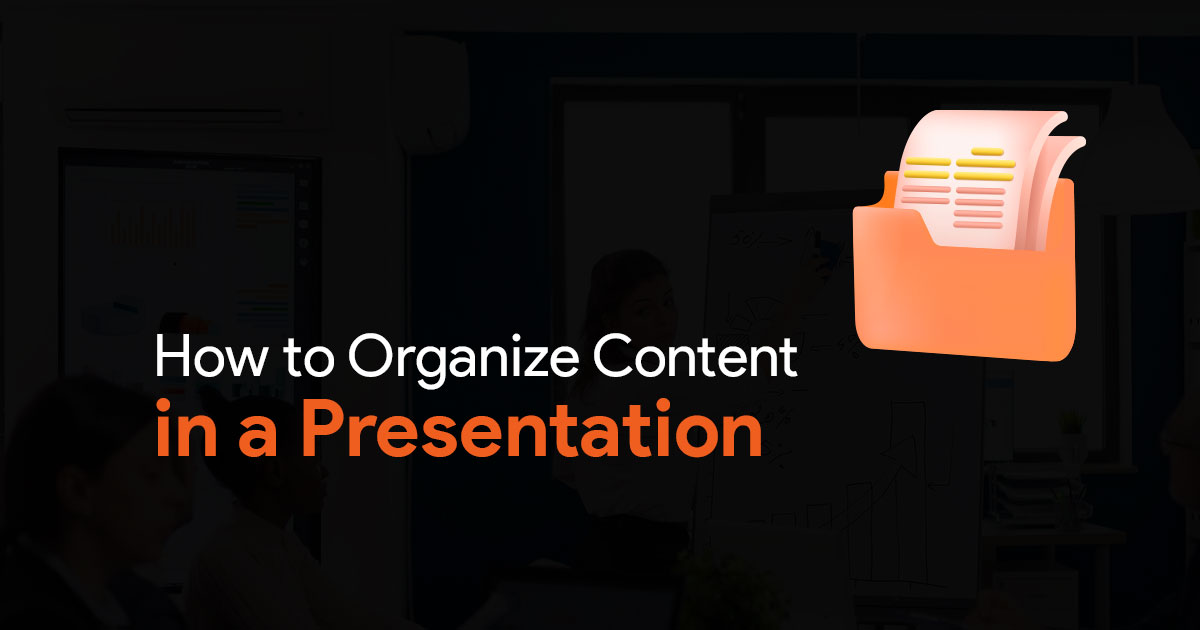How to Organize Content in a Presentation

It’s very easy to mess up a presentation. And what most people struggle with is organizing content in their presentations. When content isn’t organized well, your presentations can end up being confusing and your audience might get overwhelmed. The key to impactful presentations lies in clear organization. A well-organized presentation takes your audience on a journey, ensuring that they grasp your message and remember the key points.
Here’s why content organization matters:
Clarity: A presentation with content that is disorganized scatters attention and makes it difficult for the audience to understand your presentation. Clear organization ensures logical flow of content and helps keep everyone focused on your core message. So, if you want your users to get you, make sure your content is organized.
Engagement: Like I said above, organized content is easier to understand, and this helps you get a more engaged audience. Your audience will appreciate the presentation more and be more receptive to your ideas.
Credibility: Perhaps the most important effect of presentations with organized content is that it reflects professionalism and preparation. A well-presented message carries more weight and leaves a lasting impression on your audience.
Here are some actionable tips for content organization in your presentations:
How to Organize Content in Your Presentations
Part 1: The Content.
Start by defining your core message.
What is one key takeaway you want your audience to remember? Doing this will help you center your presentation around that core message.
Understand your audience.
Next, if you know your audience well enough, tailor your content to their level of understanding, interests and expectations.
Finally, think of what you want your audience to do after your presentation.
Work on your content with these things in mind.
Part 2: Choosing The Structure
Now comes the part where you structure your content for your presentation. Before we dive deep inro structuring the content that you created for your presentations, let’s look at some of the most common presentation structures:
Chronological: This is perfect for historical topics, timelines, or process explanations. It helps guide your audience through a sequence of events or steps in a logical order.
Problem-solution: This type of content structure is ideal for highlighting an issue, and then presenting your solution. It helps capture attention, and focuses on the problems, and at the end of your presentation, when you offer your solution, it has a good impact on your audience.
Comparative: This is great for analyzing similarities and differences between concepts, products, or situations. It helps audiences understand your content when you provide side-by-side comparisons in your presentations.
Cause and effect: This type of content structure is good for explaining the reasons behind events or outcomes. It helps you establish a clear connection between actions and consequences.
Question and answer: This makes your presentation more engaging and conversational.
Feature-benefit-action: This type of content structure is usually seen in sales presentations. It highlights features, explains their benefits and encourages specific action from the audience.
So how do you choose the right structure?
The best structure for the content in your presentation depends on your content, audience, and goals. Consider these factors before finalizing a content structure.
Part 3: Building Your Content Structure for Your Presentation
First, gather all your content that you’ve prepared and dump it all onto a document.
Now identify key points in your content. What are the essential messages you want to convey? Prioritize those points.
Group related information under relevant subheadings.
Map the flow of your content. Determine the logical progression between your key points and sub topics.
Select a structure that best aligns with your content and goals.
Now, tailor the content to fit your specific points and ensure smooth transitions between different sections.
Be sure you don’t fill slides up with too much content. Once you have a content structure ready, translate them into slides, and rehearse a few times presenting them to ensure that your content has a logical flow and is structured well.
Remember: You should always have a strong introduction and a strong conclusion to your presentation. Your introduction should capture everyone’s attention and get them interested. And your conclusion should leave your audience with the action or goal you had in mind.
Now all of this is just a framework, not a rigid formula. It may not work for all kinds of presentations. Adapt the above tips to your unique content and presentation style, while keeping in mind your audience’s understanding and engagement. By investing some time into making your content more organized, your presentations will turn out more impactful.

